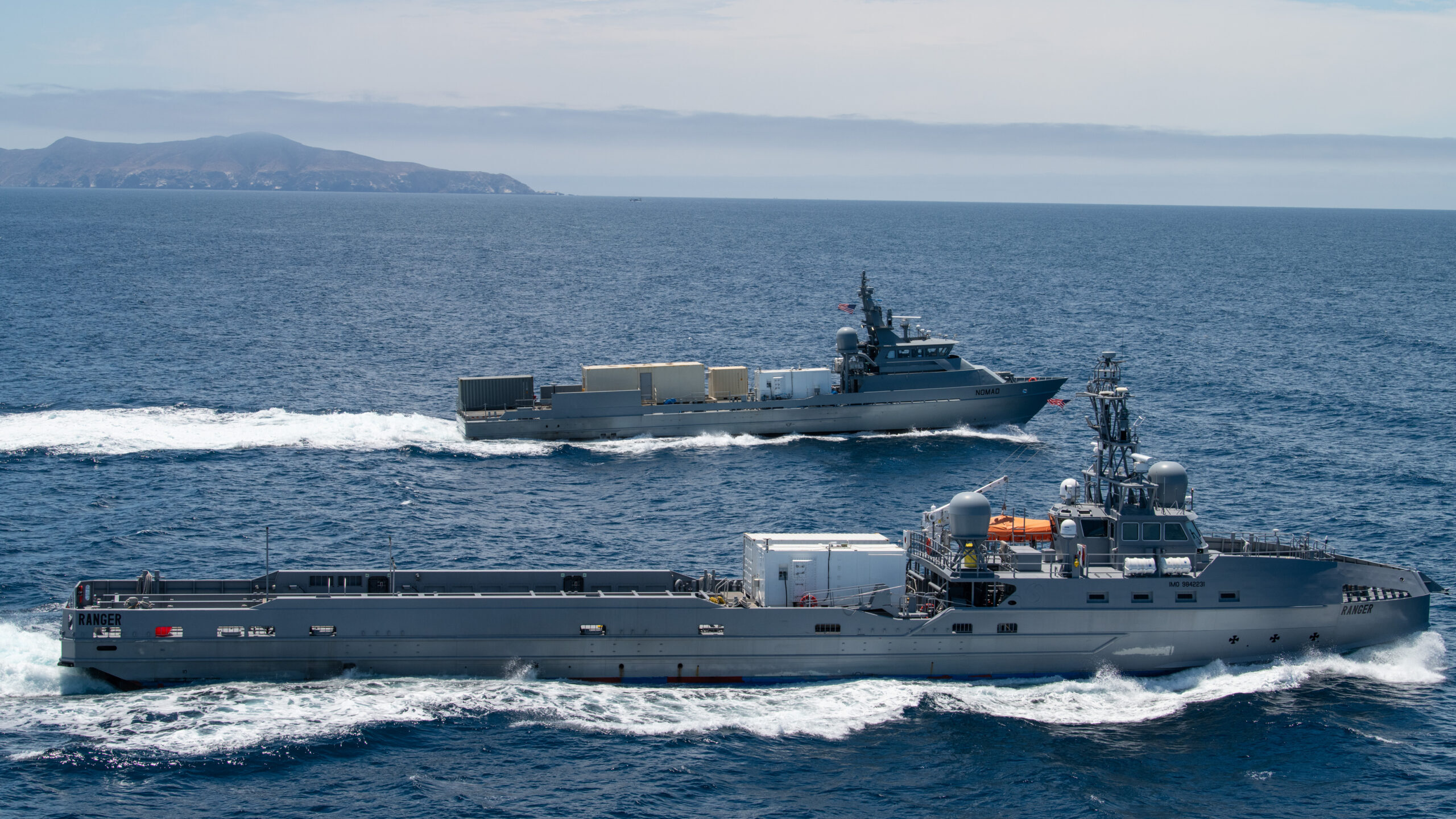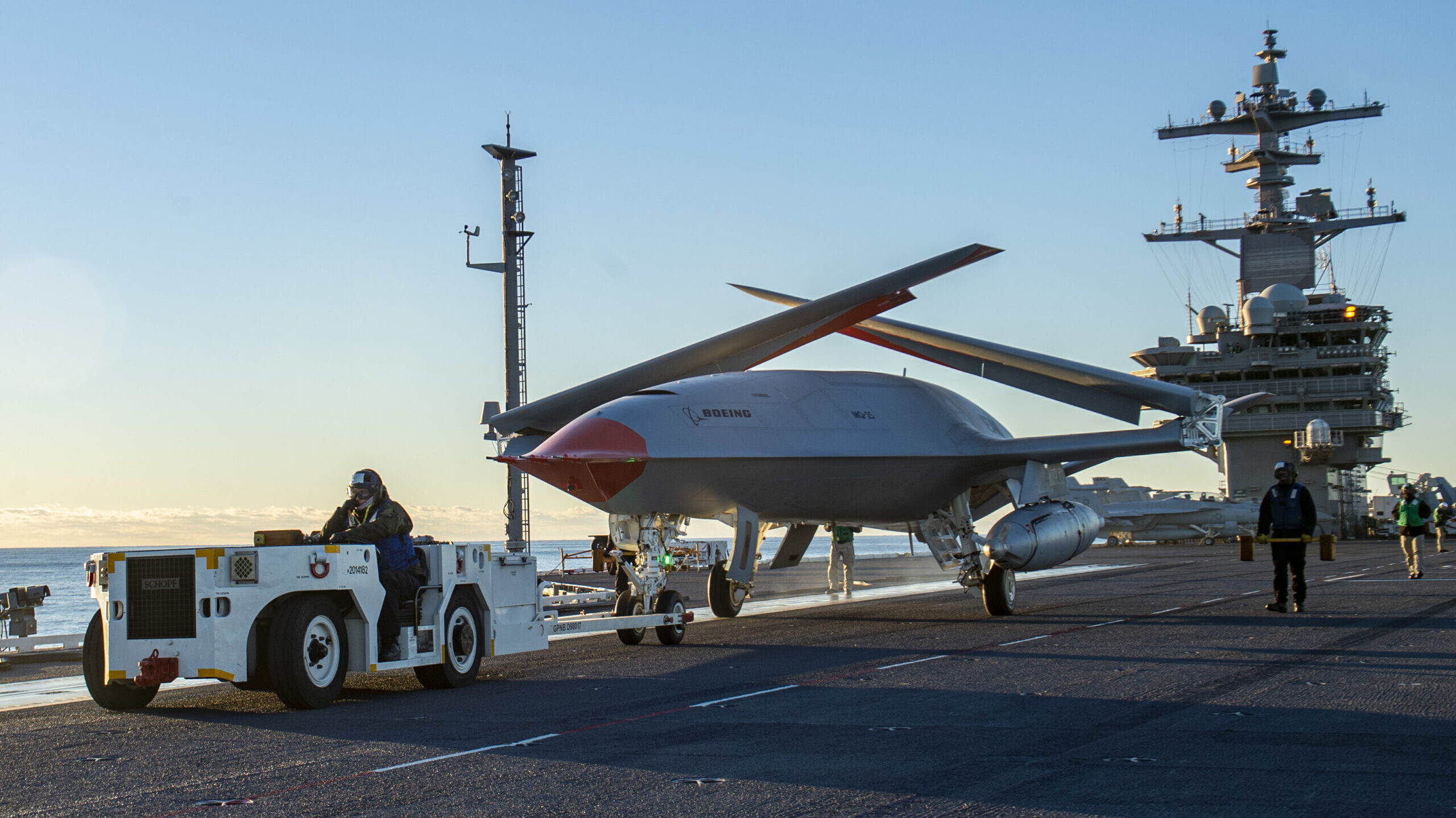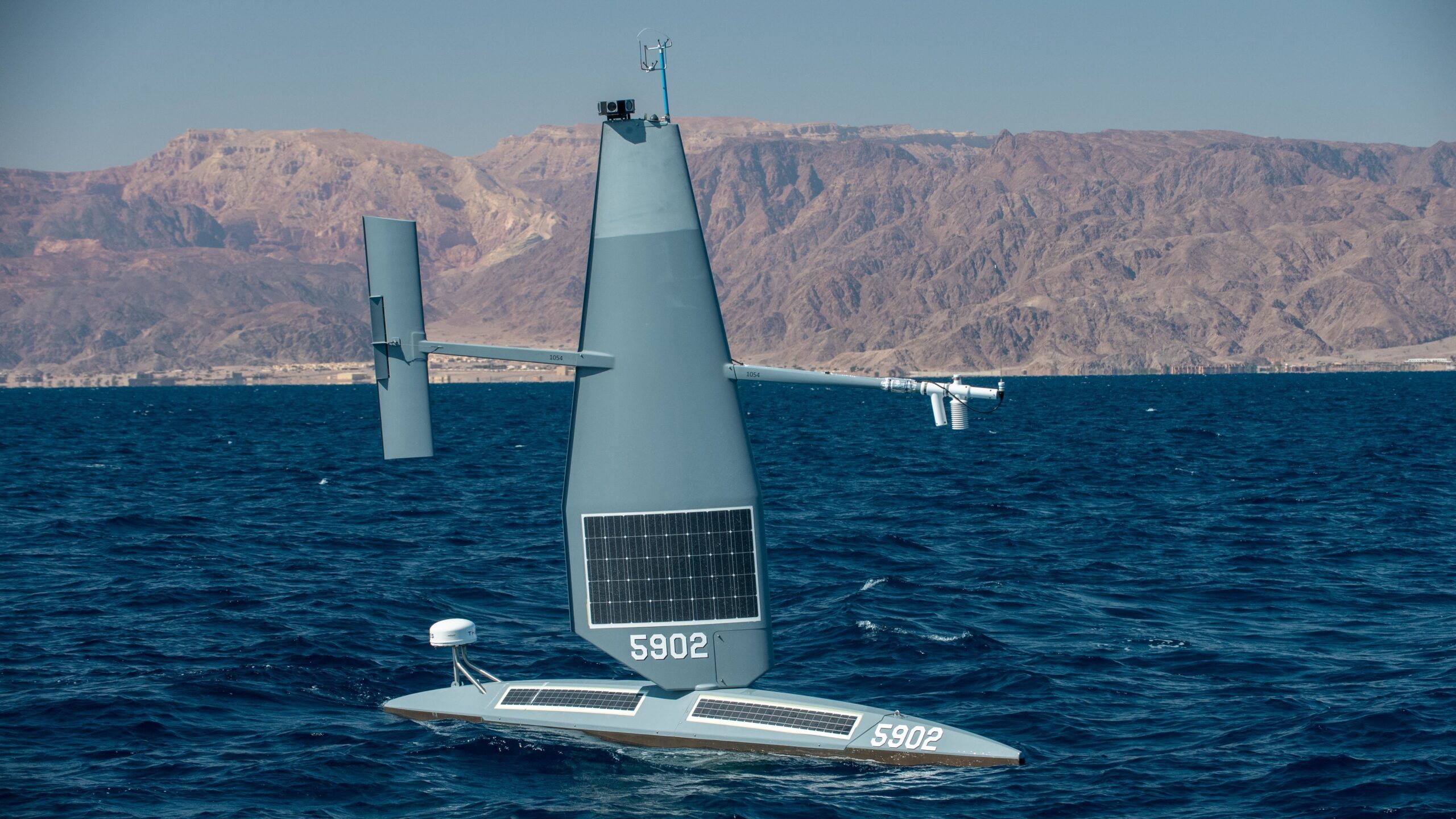
Aerial photos of USS Ranger and USS Nomad unmanned vessels underway in the Pacific Ocean near the Channel Islands on July 3, 2021. (U.S. Navy photo by Eric Parsons)
WASHINGTON: Public discussions between the Navy and Congress over unmanned technology in recent years have been circular: The service asks for funding to develop new technology, hesitant lawmakers balk at pouring millions into unproven tech, then the Navy re-ups its requests the next year, insistent the investment remains necessary.
The routine has left Congress wary of the Navy’s ideas and the service struggling to refine its pitch.
But during a year filled with international exercises, with a new task force stood up by the chief of naval operations and amid significant programmatic advances, the Navy hopes to break the cycle by changing its messaging strategy around unmanned systems: More showing, less telling.
It’s a slow shift, but analysts told Breaking Defense there are signs that the Navy has taken cues on what it will take to sway opinions in Congress towards backing more aggressive funding of unmanned technology.
“I think the new strategy by the Navy to focus on the core enabling technologies is the right strategy. [It] will bring about that comfort level from Congress that will enable the funding and allow industry to begin to scale these programs working hand in glove with the Navy,” said Michael Robbins, a spokesman for the Association for Uncrewed Vehicles Systems International, a non-profit group focused on promoting unmanned systems technology.
Recently Chief of Naval Operations Adm. Michael Gilday acknowledged that the Navy took lessons from past missteps.
“I think we’ve learned a lot, as I said, from those other classes of ships. I think that Congress is holding our feet to the fire on those lessons, and I’m 100% in support of that,” he told reporters last month.
When asked about the service’s messaging to lawmakers, Gilday highlighted Congress’ insistence on land-based testing, a process in which the Navy attempts to install and operate a new technology ashore before tampering with an operational warship. It’s a simple concept, but the Navy has infuriated lawmakers in the past when expensive programs suffered costly setbacks after skipping this step.

A Boeing unmanned MQ-25 aircraft is given operating directions on the flight deck aboard the aircraft carrier USS George H.W. Bush (CVN 77). (U.S. Navy photo by Mass Communication Specialist 3rd Class Brandon Roberson)
The Navy has learned the importance of “moving in an evolutionary, instead of a revolutionary, manner in order to deliver a platform and it’s going to be reliable and its actually going to perform as intended,” he said.
In other words, small changes with proven results over time are going to instill more confidence in lawmakers than grand proposals with questionable visions.
Rep. Rob Wittman, R-Va., ranking member on the House Armed Services seapower and projection forces subcommittee, told Breaking Defense that unmanned systems will “undeniably play a critical role” in the Navy’s fleet. He also commended the service’s tangible efforts this past year to demonstrate the technology’s capabilities.
“Still, the Navy has laid out ambitious standards for new unmanned platforms. When the service sets requirements for a large unmanned surface vessel that is able to remain underway for 60 days without human intervention, for example,” he said, “I am prone to be skeptical of their ability to meet that aim today.”
‘Promise Of The Future That Will Always Remain In The Future’
Opinions about unmanned technology, like any issue in Washington, DC, are not uniform on Capitol Hill. But the budget cuts and restrictive language in the last handful of National Defense Authorization Acts show that lawmakers have been erring on the side of caution when pitched on the biggest projects the Navy proposes.
The most ambitious efforts have usually been predicated more so on promises from service leadership rather than proven results, lawmakers complain.
“For a long time, unmanned has been the promise of the future that will always remain in the future. And that’s just where we are right now,” said Chris Brose, formerly the staff director on the Senate Armed Services Committee and current chief strategy officer of the defense contractor Anduril. “The new prioritization of trying to get capability out to the fleet fast to solve problems that unmanned systems can solve now… That to me is just a welcome improvement.”
For example, in just the past year, the service has established two task forces focused on unmanned technology: one at the CNO’s level and one based at US 5th Fleet based in Bahrain. The Strategic Capabilities Office has transferred ownership of a flagship unmanned surface vessel program to the Navy’s fleet. And the service has also publicized a variety of international exercises featuring unmanned US assets.
That is not an exhaustive list of Navy unmanned activities, but they are some of the more public events the service has flaunted in recent months to get its message across to the public and lawmakers.
“The Navy has been really focused on fielding entire systems using programs of record to move large projects forward and that’s received… significant push back from Congress,” said Robbins.
“What we’re hearing now is a different strategy from the Navy that is focused, not so much on programs of record, but instead focusing on the various enabling technologies to build these programs. I think that is a direct result of feedback from Congress,” he continued.
Not A Light Switch, But A Long, Tumultuous Road
Discussions on the Hill can sometimes make unmanned technology in the military services sound akin to that of using a light switch: it’s on or off. The Navy is using unmanned systems, or it is not. The reality is much more complicated.
When US 5th Fleet participated in the International Maritime Exercise this year, the service provided reporters with a fact sheet of roughly a dozen US unmanned assets being used. Most of them were not part of the major programs that the service brass like to highlight in front of lawmakers, such as the Large Unmanned Surface Vessel. Rather they were commercial-off-the-shelf products that industry has already refined, like the Saildrone Explorer and Devil Ray T38.
Given lawmakers’ hesitation to fund exquisite vehicles through major defense acquisition programs, industry’s ready-to-go products will prove essential if the service intends to keep developing and testing concepts of operation that incorporate unmanned vehicles — especially so following Gilday’s recent calls to incorporate more unmanned systems in the fleet within the next five years. And that integration into operations is what lawmakers have repeatedly told service brass to explain more clearly if they want to see funding.

A Saildrone Explorer unmanned surface vessel sails in the Gulf of Aqaba during International Maritime Exercise/Cutlass Express 2022. (U.S. Navy /Dawson Roth)
But integration takes time — in this case time at sea. Therein lies the friction between admirals and congressmen: the Navy can only get so far without being hands on and lawmakers will only fund so much before demanding clear results.
Paul Scharre, a technology expert at the Center for a New American Security, suggested the military’s historical transition into aviation as a point of reference. In that case the military was initially wary of integrating airplanes into its forces, and the adoption of warplanes into modern operations was a long, turbulent flight, rather than an overnight epiphany.
“There’s an element of, early on in new technology adoption, where the technology is treated as kind of special and protected in a way that it needs to be at first to be allowed to grow,” he said, “and then ideally [it] becomes sort of integrated into normal operations over time.”
This is where both Navy and Congress are at right now: unmanned technology is viewed as separate and distinct from traditional warships and planes, for better or worse.
Further, Scharre said, the roads for initial adoption for new technology such as aviation and heavy armor were “so bumpy,” he added, and the modern Pentagon’s struggle with unmanned systems is still in its early days along the same road.
Scharre pointed out one key indicator of successful adoption is when the military establishes specific communities based around the technology, such as the I Armored Corps used in World War II. But Scharre said he doesn’t believe the Navy should go as far as a separate, dedicated unmanned systems corps. “In fact, you would want them much more tightly integrated into regular operations,” he said.
RELATED: From 7 classified ‘spirals’ to coming robotic ships: Gilday on Navy’s Unmanned Task Force
The more closely the military can integrate a new technology, the less likely it is to cause a stir with congressional proponents or detractors. “I think we’re a long ways from that. But I think that’s the goal,” he added.
Those stirs often come from Congress, but they can also be from the White House. Former National Security Advisory Robert O’Brien was a fervent supporter of the military’s rapid adoption of unmanned technologies. The Trump administration’s push for unmanned systems prompted an ongoing debate among lawmakers and outside analysts about whether unmanned vessels should count as “warships” and the implications of that for the administration’s goal of a 355-ship Navy.
Brose, the Anduril executive, said he believes Gilday has come to grips with the importance of unmanned technology, and specifically the need to bring it into the fleet quicker.
“This is an imperative. China already has a larger shipbuilding industry than us, they already have a larger Navy than us,” he said. “What I hear the CNO saying, what I see the Navy starting to do is the beginnings of the realization that this isn’t a luxury anymore.”
As the most senior civilian in the Navy, and a political appointee, Navy Secretary Carlos Del Toro is ultimately responsible for delivering the service’s message to lawmakers. When asked this week at a defense conference in Washington, DC, about the service’s message on unmanned, he expressed confidence that he was on the same page as Congress.
“The Navy has a responsibility to be able to prove that the technology that Congress is going to invest in actually works and it meets what we need to address the threat,” he told reporters. “I think that’s the responsible thing to do… I don’t see it as a fight between Congress and the Department of Navy. I think we’re aligned in our thinking about what has to be done.”
With lawmakers finally moving ahead on the fiscal 2022 spending bills, soon it will once again be budget hearing season for the Navy, where Del Toro, Gilday and other Navy brass will have yet another chance to pitch Congress and demonstrate whether or not they’ve truly heeded lawmakers’ calls — and whether lawmakers, in turn, are listening to the Navy’s new message.
Multi-ship amphib buy could net $900M in savings, say Navy, Marine Corps officials
Lawmakers gave the Navy authorities to ink a multi-ship amphib deal years ago, but the service has not utilized that power yet.


























